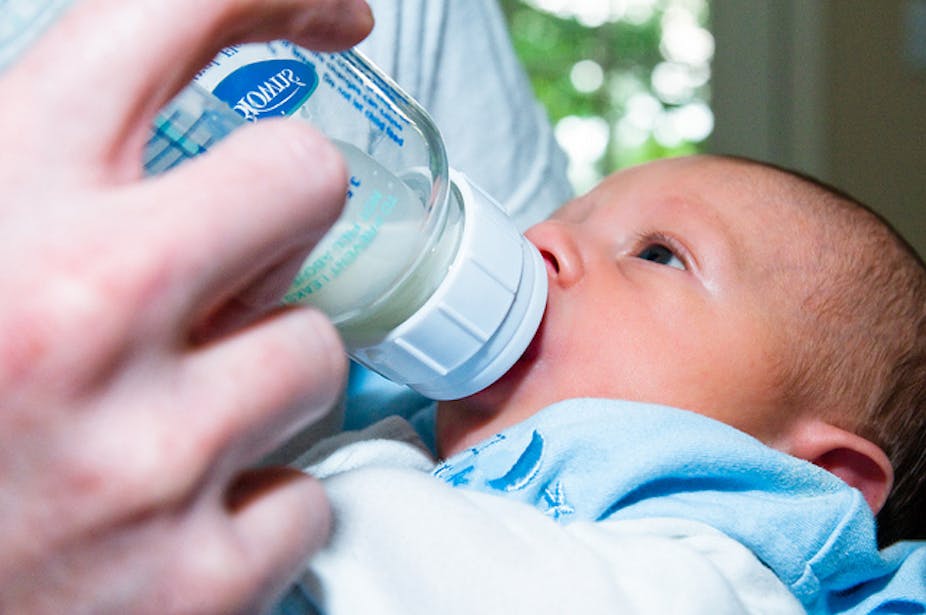A recent change to Nestlé’s NAN H.A. 1 Gold infant formula has been accused of making babies sick and irritable, with parents claiming the “new and improved” formula came with side effects such as constant crying, rashes, dark green watery poo, dehydration and vomiting.
The New South Wales Food Authority has been in contact with Nestlé about the concerns and on Friday concluded: “After reviewing information provided by Nestlé on its product, as well as the results from independent testing by a NATA accredited Australian Laboratory, the Authority is satisfied there are no food safety issues.”
Since the claims emerged, parents have vented their displeasure with Nestlé’s handling of the situation on online websites and social media. Infants under six months of age rely on breastmilk or infant formula as their sole source of nutrition, making them particularly vulnerable to any product glitches or contamination.
And given infant formula’s chequered past, it is easy to see why parents are concerned.
Early breastmilk substitutes
Historical records show that alternative feeding methods such as clay vessels were used as far back as 2000 BC. High infant mortality rates have been directly related to bacterial contamination in these alternative feeding methods and it was not until the development of glass feeding bottles and the ability to sterilise and safely store formulas that mortality rates began to decline.
Lactation failure and the need for alternate ways of feeding babies brought about the advent of the wet nurse, first in the upper classes and then more commonly among poorer women who needed to travel many miles to work in factories.
The use of wet nurses has often been controversial and the profession largely died out in the early 19th century. However, the use of another woman’s milk, or milk sharing, continues today.
First infant formula
Although human milk was promoted as the most appropriate food for infants, the search for alternatives really began in the mid-17th century. The composition of human milk was compared to the milk of other mammals including cows, mares, ass, sheep and goats. Scientists started to formulate non-human milk in attempt to replicate human breastmilk.
In 1835, evaporated milk was first patented and the popular Eagle Brand Condensed Milk was developed in 1853. Then, in 1865, a chemist developed an infant food consisting of cow’s milk, wheat and malt flour, and potassium bicarbonate and touted as the perfect infant food. There were 27 patented brands of formula available by 1883.
The growth of the infant formula industry continued, as did the variety of the available formulas, most of which are now manufactured by multinational pharmaceutical companies. Aggressive marketing of formula and feeding products has ensured it has become a multibillion dollar industry and has seen a steep decline in breastfeeding.
Formula tragedies
Infant formula history is littered with mistakes, contamination and recalls. Between 1982 to 1994 in the United States alone there were 22 significant recalls due to health and safety concerns. Tens of thousands of products were recalled.
In 2005, a soy-based formula in Israel was found to be thiamine-deficient, leading to the hospitalisation of 20 babies, the deaths of three babies and irreversible brain damage for others.
In 2006, bogus formulas in China were blamed for the deaths of 60 infants and resulted in severe malnutrition of hundreds of babies. Glass fragments, metal shavings, cockroaches and bacteria have all been found in these products and caused harm to babies.
Contamination of Chinese formula with melamine in 2008 also led to deaths and hospitalisations.
Breast is normal
While these details are shocking enough, what we should be more concerned about are the short and long-term repercussions of all babies who are not breastfed. The World Health Organisation recommends exclusive breastfeeding to around six months, with gradual introduction of appropriate complementary foods and continued breastfeeding until the child is two years or older.

In Australia, well over 90% of babies will initiate breastfeeding; however this number falls dramatically, with only around 14% being exclusively breastfed at six months of age. This is concerning because infants who are formula fed from birth face higher rates of respiratory and gastrointestinal illness than their breastfed peers.
Add to this the inherent risks of relying on a manufactured, and therefore vulnerable product, which provides basic nutrition at the best of times.
When an infant breastfeeds, he or she is taking in a dynamic food. Early milk or colostrum provides the very first immunity and coats the fragile gut lining. Constituents of breastmilk change within a feed, between feeds and over time, responding to the needs of the growing child. No manufactured product can ever hope to mimic these properties.
When considering the impact of infant formula on a child’s health, it’s important to remember that the first priority of formula companies is profit for their shareholders; it is not to ensure that babies receive the most appropriate nutrition: their own mother’s breastmilk.

